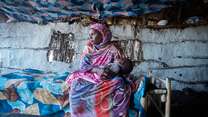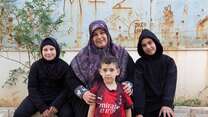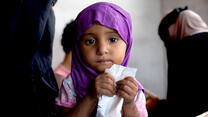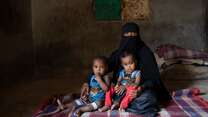Recent data reveals that Yemen is now the world's third biggest food crisis,[1]with half of its population facing hunger, and nearly half of all children under five suffering from chronic malnutrition.[2]On World Food Day, international and national organizations in Yemen are calling for urgent action to address the escalating hunger crisis in the country.
Yemen is facing an alarming humanitarian emergency, with an increasing number of people deprived of food and one in three families facing moderate to severe hunger. Over 100 districts now face a critical nutrition emergency, an unprecedented increase in malnutrition levels across the country.[3] In Abs District, Hajjah, children have died of starvation as malnutrition rates soared, while in Al Hodeida and Taiz, a projected 15 - 30 percent rise in acute malnutrition is expected by the end of the year.[4]
The situation is rapidly deteriorating. By early 2026, over 18 million people across Yemen are expected to face crisis levels of hunger, including approximately 41,000 at risk of famine.[5]
Across the country, families are now being driven into impossible choices — parents are skipping meals so their children can eat, selling off land, livestock, or their few belongings just to survive. As a mother from Al Dhale’ shared: “There are days when I send my daughter to her grandfather’s house just so she can eat, while I go without. On other days, we eat just bread and drink tea. As a mother, it breaks me.”
The impacts of the current crisis are intergenerational. Children are among the hardest hit — losing not only their health, as hunger robs them of their physical and cognitive development, increasing lifelong health risks, but also their hopes for the future. As families struggle to survive, many have been forced to take their children out of school, send them to work, or marry them off early, exposing them to further risks.
Driving factors
Conflict, economic collapse, climate shocks and water scarcity are pushing Yemen towards famine. Years of war and displacement have eroded livelihoods, limiting access to basic health and nutrition services. As is more often the case, women and girls have been disproportionately affected. Now recovery efforts are stalling with rising food prices, currency devaluation and economic fragmentation pushing millions deeper into crisis. The latest floods this August are a stark example of how climate change is limiting the availability of food, destroying farmland, livestock, and other essential sources of sustenance.
While conditions are challenging across Yemen, in northern governorates, the ongoing detention of humanitarian staff has further obstructed lifesaving aid operations. The restriction of movement imposed on female Yemeni aid workers, which prevents them from travelling without male guardians, also continues to impede humanitarian delivery and limits the ability of vulnerable women and girls to access humanitarian services.
Unprecedented global aid cuts in 2025 have further driven hunger and child malnutrition to deadly levels.[6] Funding cuts have forced the shutdown of over 2,800 lifesaving treatment services, representing nearly half of all lifesaving nutrition programming.[7]Nearly all supply pipelines, which serve millions of malnourished children, as well as pregnant and breastfeeding women, are under severe strain. Despite rising needs, Yemen’s food security and nutrition responses are at its lowest in a decade, with barely 10 percent of funding needs met.[8]
Taking Effective Solutions Further
Over the past decade, international and local organizations in Yemen have helped prevent famine from taking hold and saved countless lives. With the support of donors we have restored irrigation systems, provided cash assistance and vocational training to help families rebuild their livelihoods. These efforts have kept children nourished, supported parents to earn an income, and revived small-scale farming. However, without sustained, long-term investment, the tide will turn. More districts are at imminent risk of sliding into catastrophic levels of malnutrition[9]without urgent funding and supplies.
Donors Must Step Up
As the world marks World Food Day, the international community must scale up support for proven solutions to allow humanitarian actors to tackle Yemen’s worsening hunger crisis, protect children and families and prevent increased suffering. Equally important is addressing the root causes of Yemen’s food insecurity: an end to the conflict which requires meaningful progress in the peace process and robust recovery efforts, including stabilization of the economy and investments in climate resilient agriculture and livelihoods. Only through a combined effort — linking immediate life-saving support with long-term political and economic solutions — can Yemenis rebuild their lives.
We call on:
- Donors and international partners to fund immediate food security and livelihood needs identified in the Food Security and Agriculture Cluster hyper-prioritized plan,[10] with a focus on hotspot districts and the restoration of critical supply pipelines. Support will enable lifesaving nutrition services, including the continued operation of therapeutic feeding centers and access to essential treatment supplies.
- Donors and international partners to increase investment in national organizations as a critical effort towards advancing the localization agenda, while ensuring communities are supported faster and more effectively.
- Donors and international partners to jointly advocate for principled humanitarian access across Yemen, facilitating the timely delivery of targeted and complementary food, nutrition and cash assistance.
- Donors and international partners to urgently ensure that humanitarian programs across Yemen integrate measures to safeguard vulnerable communities, particularly women and children, addressing the rising risks they face due to the escalating hunger crisis, including forced child labor, early marriage, and school dropout.
- Development donors to invest in robust disaster risk management strategies. Resilient infrastructure and community preparedness initiatives, including social transfers, are critical to minimize risks of climate change and protect the most vulnerable populations.
- Parties to the conflict must facilitate principled and unhindered humanitarian access to ensure the timely delivery of lifesaving assistance, and the recovery of their communities from severe hunger and malnutrition. All arbitrarily detained humanitarian workers should be released, and the safety and continuity of humanitarian operations should be ensured.
- Parties to the conflict, with the support of the international community, to take steps towards peace efforts including economic relief measures - such as resuming public sector salary payments, restoring banking operations, and curbing currency depreciation - to reduce the drivers of hunger and enable families to afford food and basic needs.
ENDS [ARABIC VERSION ATTACHED]
Signed by:
Action Contre la Faim (ACF)
Action for Humanity
Aden Foundation for Arts and Sciences (ADEN-FAS)
Al-Ahlam Foundation for Developmental Medicine
All Girls Foundation For Development (AGF)
CARE
Child and Youth Protection Foundation (CYPF)
Center For Civilians In Conflict (CIVIC)
Danish Refugee Council (DRC)
Deem for Development Organization
Direct Aid (DA)
Dorcas
FARHM Network for Peace and Development (network of 10 Yemeni organizations)
Field Medical Foundation (FMF)
Generations Without Qat (GWQ)
Geneva Call
Human Access for Partnership and Development
International Medical Corps
International Rescue Committee (IRC)
INTERSOS
Joud Al Ata a Foundation Humanity Development (JAFHD)
Médecins du Monde (MdM)
Norwegian People’s Aid (NPA)
OXFAM
Relief & Development Peer Foundation (RDP)
Relief International (RI)
Save the Children
Secours Islamique France (SIF)
Society for Humanitarian Solidarity (SHS)
SOUL for Development (SOUL)
War Child Alliance
Notes to Editors
- Data from assessments conducted in Taiz, Al Dhae’e, Abyan and Al Hodiedah in August 2025, reveal that half of all households with children under five had at least one malnourished child during the last three months, while 1 in 4 households had at least one malnourished pregnant or lactating woman (PLW) during the same period.
- Malnourished children are about ten times more likely to die from common illnesses than well-nourished children, leaving them at risk of stunting—a form of chronic malnutrition that impairs normal physical and cognitive development—along with irreversible developmental delays, lifelong health struggles, and diminished prospects for the future. Without treatment, their bodies enter full starvation, breaking down protein—the essential tissue needed for survival—until they slowly and painfully die. Yemen’s future generation is at risk, and assistance must reach them as soon as possible.
[1]. Mr. Tom Fletcher, Under-Secretary-General for Humanitarian Affairs and Emergency Relief Coordinator – Briefing to the Security Council on the humanitarian situation in Yemen, 15 September 2025 | OCHA
[2] Approximately 18.1 million people are facing hunger and 49% of children under 5 are facing chronic malnutrition, Nutrition Cluster, Oct 2025.
[3] Nutrition Cluster, Oct 2025.
[4] Nutrition Cluster, Oct 2025.
[5] Food insecurity levels are based on the Integrated Food Security Phase Classification (IPC), where Phase 3 indicates crisis levels of food insecurity and Phase 5 indicates catastrophic or famine conditions. IPC projects Phase 5 (Catastrophic) conditions in four districts within Amran, Al Hodeidah and Hajjah governorates.
[6] IPC projections from Sept 2025 - Feb 2026 mark a record-high number of areas classified in Phase 4 (Emergency).
[7] 377 Outpatient Therapeutic Program (OTP) sites, 2,376 Targeted Supplementary Feeding Program (TSFP) sites, 77 mobile teams, and 21 Therapeutic Feeding Centers (TFCs) have closed due to a shortfall in funds (Nutrition Cluster, Oct 2025).
[8] Yemen Humanitarian Needs and Response Plan 2025. https://fts.unocha.org/plans/1262/global-clusters.
[9] IPC Acute Malnutrition (AMN) Phase 5.
[10] Yemen Food Security and Agriculture hyper-prioritized response plan, July- Dec 2025. https://fscluster.org/yemen/document/yemen-fsac-hyper-prioritized-response.



